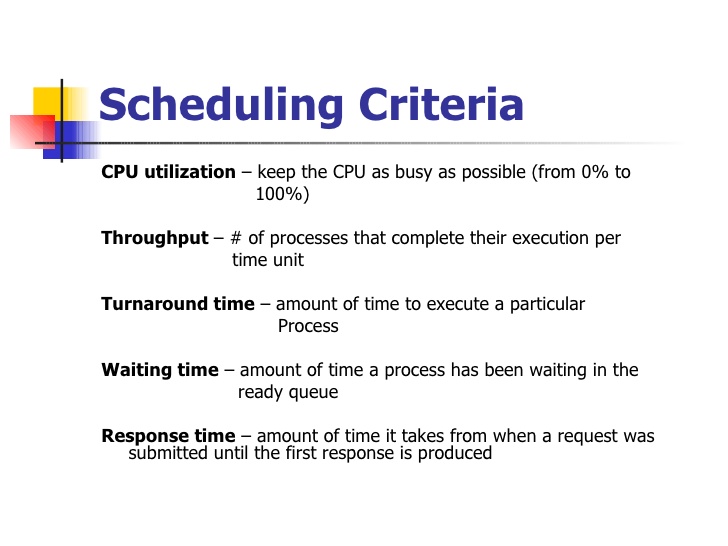In computing, scheduling is the method by which work specified by some means is assigned to resources that complete the work. The work may be virtual computation elements such as threads, processes or data flows, which are in turn scheduled onto hardware resources such as processors, network links or expansion cards.
A scheduler is what carries out the scheduling activity. Schedulers are often implemented so they keep all compute resources busy (as in load balancing), allow multiple users to share system resources effectively, or to achieve a target quality of service. Scheduling is fundamental to computation itself, and an intrinsic part of the execution model of a computer system; the concept of scheduling makes it possible to have computer multitasking with a single central processing unit (CPU).
A scheduler may aim at one of many goals, for example, maximizing throughput (the total amount of work completed per time unit), minimizing response time (time from work becoming enabled until the first point it begins execution on resources), or minimizing latency (the time between work becoming enabled and its subsequent completion), maximizing fairness (equal CPU time to each process, or more generally appropriate times according to the priority and workload of each process). In practice, these goals often conflict (e.g. throughput versus latency), thus a scheduler will implement a suitable compromise. Preference is given to any one of the concerns mentioned above, depending upon the user's needs and objectives.
In real-time environments, such as embedded systems for automatic control in industry (for example robotics), the scheduler also must ensure that processes can meet deadline
Types of operating system schedulers
See also: Network scheduler, I/O scheduling and Job scheduler
The scheduler is an operating system module that selects the next jobs to be admitted into the system and the next process to run. Operating systems may feature up to three distinct scheduler types: a long-term scheduler (also known as an admission scheduler or high-level scheduler), a mid-term or medium-term scheduler, and a short-term scheduler. The names suggest the relative frequency with which their functions are performed.
Process scheduler
The process scheduler is a part of the operating system that decides which process runs at a certain point in time. It usually has the ability to pause a running process, move it to the back of the running queue and start a new process; such a scheduler is known as preemptive scheduler, otherwise it is a cooperative scheduler.
Long-term scheduling
The long-term scheduler, or admission scheduler, decides which jobs or processes are to be admitted to the ready queue (in main memory); that is, when an attempt is made to execute a program, its admission to the set of currently executing processes is either authorized or delayed by the long-term scheduler. Thus, this scheduler dictates what processes are to run on a system, and the degree of concurrency to be supported at any one time – whether many or few processes are to be executed concurrently, and how the split between I/O-intensive and CPU-intensive processes is to be handled. The long-term scheduler is responsible for controlling the degree of multiprogramming.
In general, most processes can be described as either I/O-bound or CPU-bound. An I/O-bound process is one that spends more of its time doing I/O than it spends doing computations. A CPU-bound process, in contrast, generates I/O requests infrequently, using more of its time doing computations. It is important that a long-term scheduler selects a good process mix of I/O-bound and CPU-bound processes. If all processes are I/O-bound, the ready queue will almost always be empty, and the short-term scheduler will have little to do. On the other hand, if all processes are CPU-bound, the I/O waiting queue will almost always be empty, devices will go unused, and again the system will be unbalanced. The system with the best performance will thus have a combination of CPU-bound and I/O-bound processes. In modern operating systems, this is used to make sure that real-time processes get enough CPU time to finish their tasks.
Long-term scheduling is also important in large-scale systems such as batch processing systems, computer clusters, supercomputers, and render farms. For example, in concurrent systems, coscheduling of interacting processes is often required to prevent them from blocking due to waiting on each other. In these cases, special-purpose job scheduler software is typically used to assist these functions, in addition to any underlying admission scheduling support in the operating system.

